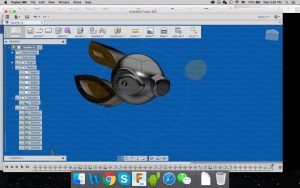Autodesk Fusion 360 is the closest UI that comes to mind, bridging the tangible and the digital through 3D printing. It still shares a great deal of its UI with purely digital programs like Paint or Illustrator; users utilize the select, resize, and click interface and can quickly undo changes if they don’t like them. However, it also asks users to pretend that they are working within a 3d realm. Clicking extrude simulates the effect of building layers. Toggling effects like bevel smooth out corners into rounded edges. By inputting a radius and a click, we can stamp a hole in our work.
After compiling the code and as we print, we can see the extension of our creativity through the hot tip of the extruder. It acts not in lieu of us, but with us, applying a mechanical hand driven by digital instructions originating from our mind. In a sense this UI both complements and goes against McCullough’s arguments. Just as industrial design fused artistic expression with technology, so do we when we 3D print. However at the same time, his argument—that software currently is merely the labor of our minds—is not disproven by Autodesk Fusion 360.
If I could redesign aspects of the software and if I had the technical/scientific chops, I would consider adding a holographic projection portion to the software. This way, instead of dragging the mouse around to “camera/zoom” view my model, I would be able to circle around it and observe it as if it were physical. Perhaps, the software could be improved by functional phicons, like a knife that could digitally slice the model. This knife would be analogous to the ActiveLens from metaDesk that emulated a jeweler’s magnifying glass.

The last thing I attempted to make on Autodesk Fusion 360-Stitch from Lilo & Stitch. Obviously I wasn’t getting too far, haha.
